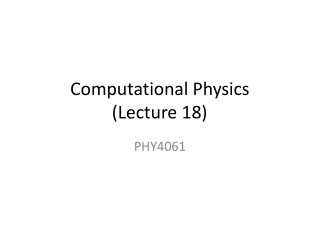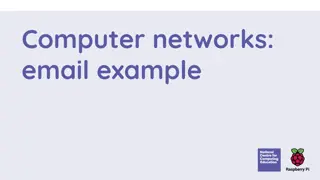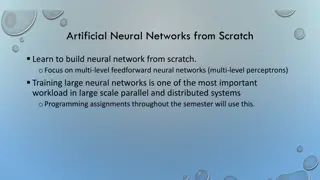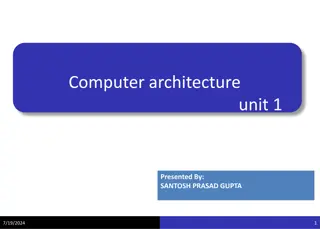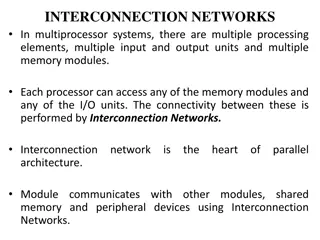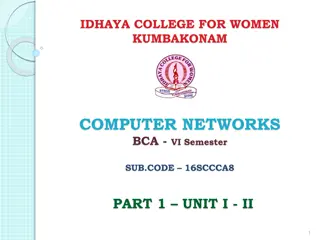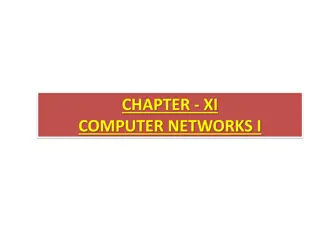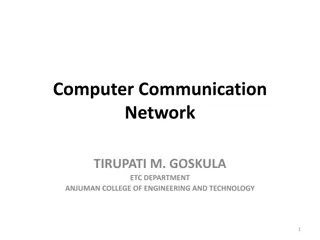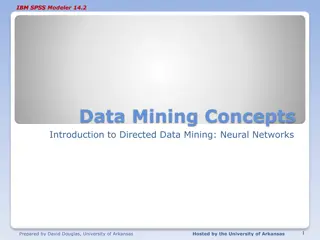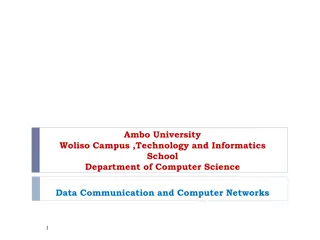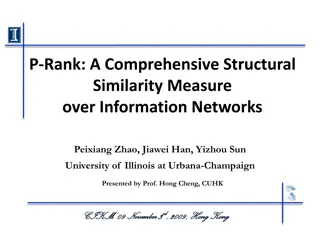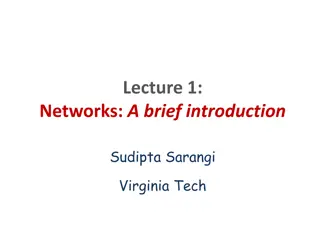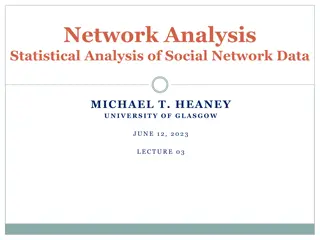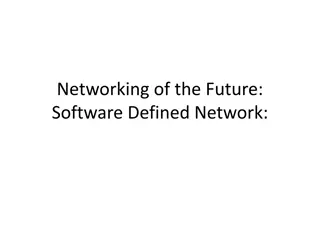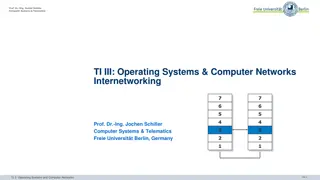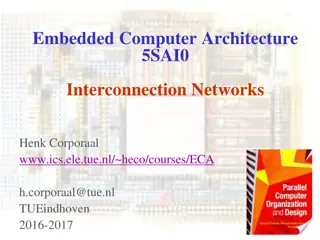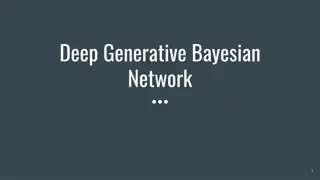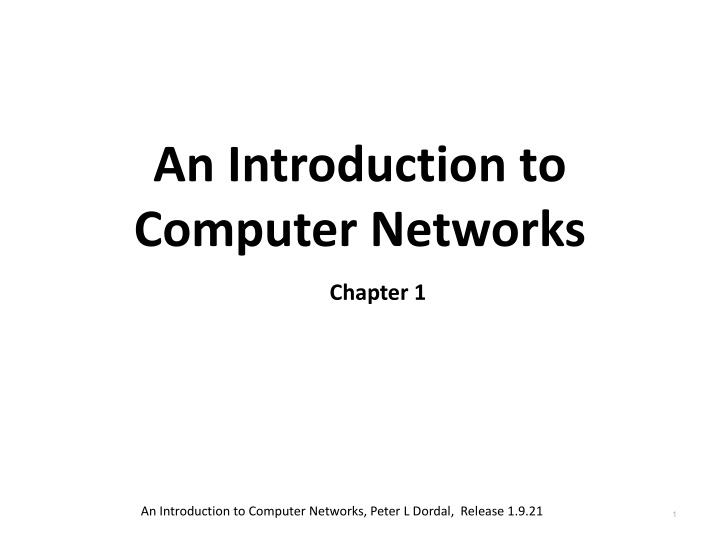
Computer Networks: Layers, LANs, and Protocols
Explore the fundamentals of computer networks, including LANs, IP, TCP, and the four-layer model. Learn about the Application layer with protocols like DNS and HTTP, and understand the role of the Transport layer with TCP and UDP protocols. Dive into the connections between machines within LANs and how they interact with other networks.
Download Presentation

Please find below an Image/Link to download the presentation.
The content on the website is provided AS IS for your information and personal use only. It may not be sold, licensed, or shared on other websites without obtaining consent from the author. If you encounter any issues during the download, it is possible that the publisher has removed the file from their server.
You are allowed to download the files provided on this website for personal or commercial use, subject to the condition that they are used lawfully. All files are the property of their respective owners.
The content on the website is provided AS IS for your information and personal use only. It may not be sold, licensed, or shared on other websites without obtaining consent from the author.
E N D
Presentation Transcript
An Introduction to Computer Networks Chapter 1 An Introduction to Computer Networks, Peter L Dordal, Release 1.9.21 1
An Overview of Networks Local Area Networks (LANs), are the physical networks that provide the connection between machines within, say, a home, school or corporation. LANs can maintain connections with other LANs via leased lines, leased services, or across the Internet using virtual private network technologies LANs are local ; it is the Internet Protocol (IP) layer that provides an abstraction for connecting multiple LANs into the Internet. Finally, Transfer Control Protocol (TCP) deals with transport and connections and actually sending user data. An Introduction to Computer Networks, Peter L Dordal, Release 1.9.21 2
An Overview of Networks An Introduction to Computer Networks, Peter L Dordal, Release 1.9.21 3
Layers These three topics LANs, IP and TCP are often called layers; constitute the Application layer, Transport layer, Internet layer, and Link or network layer respectively. These form the four-layer model for networks. An Introduction to Computer Networks, Peter L Dordal, Release 1.9.21 4
Layers Application layer is the top-most layer of four-layer TCP/IP model: Application layer is placed on the top of the Transport layer. Application layer defines TCP/IP application protocols and how host programs interface with Transport layer services to use the network Application layer includes protocols like DNS (Domain Naming System), HTTP (Hypertext Transfer Protocol), Telnet, SSH, FTP (File Transfer Protocol), TFTP (Trivial File Transfer Protocol), SNMP (Simple Network Management Protocol), SMTP (Simple Mail Transfer Protocol) , DHCP (Dynamic Host Configuration Protocol), RDP (Remote Desktop Protocol) etc. An Introduction to Computer Networks, Peter L Dordal, Release 1.9.21 5
Layers Transport Layer is the third layer of the four-layer TCP/IP model. The position of the Transport layer is between Application layer and Internet layer. The purpose of Transport layer is to permit devices on the source and destination hosts to carry on a conversation. Transport layer defines the level of service and status of the connection used when transporting data. The main protocols included at Transport layer are TCP (Transmission Control Protocol) and UDP (User Datagram Protocol). An Introduction to Computer Networks, Peter L Dordal, Release 1.9.21 6
Layers Internet Layer (also called as IP layer)is the second layer of the four-layer TCP/IP model. The position of Internet layer is between Network Layer and Transport layer. Internet layer pack data into data packets known as IP datagrams, which contain source and destination address (logical address or IP address) information that is used to forward the datagrams between hosts and across networks. Internet layer allow hosts to insert data packets into network and have them delivered to the destination, on the same network or on another remote network. The main protocols included at Internet layer are IP (Internet Protocol), ICMP (Internet Control Message Protocol), ARP (Address Resolution Protocol), RARP (Reverse Address Resolution Protocol) and IGMP (Internet Group Management Protocol). An Introduction to Computer Networks, Peter L Dordal, Release 1.9.21 7
Layers Network Layer (also called as LAN Layer) is the first layer of the four-layer TCP/IP model: Network Layer defines details of how data is physically sent through the network, including how bits are signaled directly with a network medium, such as coaxial cable, optical fiber, or twisted pair copper wire. The protocols in Network Layer are Ethernet, Token Ring, FDDI, X.25, Frame Relay etc. The most popular LAN architecture among those listed above is Ethernet. Ethernet uses an Access Method called CSMA/CD (Carrier Sense Multiple Access/Collision Detection) to access the media, the Access Method determines how a host will place data on the medium. An Introduction to Computer Networks, Peter L Dordal, Release 1.9.21 8
LAN layer LAN layer is in charge of actual delivery of data packets, using LAN-layer-supplied addresses. The LAN layer is often conceptually subdivided into the physical layer dealing with, the analog electrical, optical or radio signaling mechanisms. The physical layer is generally of direct concern to LAN hardware; the kernel software interface to the LAN corresponds to the logical LAN layer. The LAN layer covers packet addressing, delivery and receipt, forwarding, error detection, collision detection and collision-related retransmission attempts. An application does not interact directly with the IP and LAN layers at all. An Introduction to Computer Networks, Peter L Dordal, Release 1.9.21 9
The LAN Layer In IEEE protocols, the LAN layer is divided into the Media Access Control (MAC) sub layer and a Logical Link Control (LLC), sub layer for higher level flow control functions that today have moved largely to the transport layer. In particular, LAN-layer addresses are perhaps most often called MAC addresses. Much of the operation of the LAN/MAC layer takes place in the network card. An Introduction to Computer Networks, Peter L Dordal, Release 1.9.21 10
Five Layer Model This LAN physical/logical division gives us the Internet five-layer model. An Introduction to Computer Networks, Peter L Dordal, Release 1.9.21 11
Data Rate, Throughput and Bandwidth Any network connection at the LAN layer has a; Data rate: the rate at which bits are transmitted. In some LANs (e.g Wi-Fi) the data rate can vary with time. Bandwidth: is mostly as a synonym for data rate. The term comes from radio transmission, the width of its frequency band Goodput: is sometimes called application-layer throughput , the amount of usable data delivered to the receiving application. Data rates are generally measured in kilobits per second (kbps) or megabits per second (Mbps) An Introduction to Computer Networks, Peter L Dordal, Release 1.9.21 12
Packets Packets are the modest-sized buffers of data, transmitted as a unit through some shared set of links. Packets need to be prefixed with a header containing delivery information. In the common case known as datagram forwarding; The header contains a destination address; headers in networks using so-called virtual-circuit forwarding. Almost all networking today is packet-based An Introduction to Computer Networks, Peter L Dordal, Release 1.9.21 13
Packets An Introduction to Computer Networks, Peter L Dordal, Release 1.9.21 14
Packets At the LAN layer, packets can be viewed as the imposition of a buffer (and addressing) structure on top of low-level serial data lines; additional layers then impose additional structure. Informally, packets are often referred to as frames at the LAN layer, and as segments at the Transport layer. An Introduction to Computer Networks, Peter L Dordal, Release 1.9.21 15
Packets The maximum packet size supported by a given LAN based on its transfer mode (Ethernet, Token Ring or ATM): Ethernet allows a maximum of 1500 bytes of data. TCP/IP packets originally often held only 512 bytes of data. Early Token Ring packets could contain up to 4KB of data. ATM (Asynchronous Transfer Mode) protocol uses 48 bytes of data per packet, and there are good reasons for believing in modest packet sizes. There are proponents of very large packet sizes, larger even than 64 KB, at the other extreme An Introduction to Computer Networks, Peter L Dordal, Release 1.9.21 16
Packets One potential packet transfer issue is how to forward packets from a large-packet LAN to a small- packet LAN; Generally each layer adds its own header. Ethernet headers are typically 14 bytes, IP headers 20 bytes, and TCP headers 20 bytes. If a TCP connection sends 512 bytes of data per packet, then the headers amount to 10% of the total, a not- unreasonable overhead. For one common Voice-over-IP option, packets contain 160 bytes of data and 54 bytes of headers. An Introduction to Computer Networks, Peter L Dordal, Release 1.9.21 17
Packets In datagram-forwarding networks, the appropriate header contains the address of the destination and other delivery information. Internal nodes of the network called routers or switches will then try to ensure that the packet is delivered to the requested destination. The early Internet specifications introduced the term octet (an 8-bit byte) and required that packets be sequences of octets. An Introduction to Computer Networks, Peter L Dordal, Release 1.9.21 18
Datagram Forwarding In the datagram-forwarding model of packet delivery, packet headers contain a destination address. switches or routers to look at this address and direct the packet to the correct destination. In datagram forwarding this is achieved by providing each switch/router with a forwarding table of <destination, next_hop> pairs. When a packet arrives, the switch/router looks up the destination address in its forwarding table and finds the next_hop information. An Introduction to Computer Networks, Peter L Dordal, Release 1.9.21 19
Datagram Forwarding When a packet arrives, the immediate-neighbor address (next_hop) to which the packet should be forwarded in order to bring it one step closer to its final destination: The next_hop value in a forwarding table is a single entry; each switch is responsible for only one step in the packet s path. However, if all is well, the network switches will be able to deliver the packet, one hop at a time, to its ultimate destination. The destination entries in the forwarding table do not have to correspond exactly with the packet destination addresses. An Introduction to Computer Networks, Peter L Dordal, Release 1.9.21 20
Datagram Forwarding For IP routing, the table destination entries will correspond to prefixes of IP addresses; this leads to a huge savings in space. The fundamental requirement is that the switch can perform a lookup operation using its forwarding table and the destination address in the arriving packet, to determine the next-hop. An Introduction to Computer Networks, Peter L Dordal, Release 1.9.21 21
Datagram Forwarding In the diagram below, switch S1 has interfaces 0, 1 and 2, and S2 has interfaces 0,1,2,and 3. If A is to send a packet to B, S1 must have a forwarding-table entry indicating that destination B is reached via its interface 2, and S2 must have an entry forwarding the packet out on interface 3. An Introduction to Computer Networks, Peter L Dordal, Release 1.9.21 22
Datagram Forwarding An Introduction to Computer Networks, Peter L Dordal, Release 1.9.21 23
Datagram Forwarding In the previous network diagram, all links are point-to-point, and each interface corresponds to the immediate neighbor. We can thus replace the interface entries in the next_hop column with the name of the corresponding neighbor. An Introduction to Computer Networks, Peter L Dordal, Release 1.9.21 24
Datagram Forwarding A central feature of datagram forwarding is that each packet is forwarded in isolation ; the switches involved do not have any awareness of any higher-layer logical connections established between endpoints. This is also called stateless forwarding, in that the forwarding tables have no per-connection state. An Introduction to Computer Networks, Peter L Dordal, Release 1.9.21 25
Datagram Forwarding The fundamental alternative to datagram forwarding is virtual circuits: In virtual circuit networks, each router maintains state about each connection passing through it; different connections can be routed differently. By convention, switching devices; acting at the LAN layer and forwarding packets based on the LAN address are called switches. acting at the IP layer and forwarding on the IP address are called routers. An Introduction to Computer Networks, Peter L Dordal, Release 1.9.21 26
Datagram Forwarding In IP routers, it is common for a forwarding table to include a default entry, matching any IP address that is nonlocal and so needs to be routed out into the next level. A default entry is a single record representing where to forward the packet if no other destination match is found. Here is a forwarding table for S1 (from previous diagram) with a default entry replacing the last three entries: An Introduction to Computer Networks, Peter L Dordal, Release 1.9.21 27
Network Topology Consider, the following four network switches: Should S1 list S2 or S3 as the next_hop to B from A? Both paths A-S1-S2-S4-B and A-S1-S3-S4-B get there. There is no right answer! Some sort of protocol must exist to provide a mechanism by which S1 can make the choice. Protocols needed to make sure that, if S1 reaches B via S2 and the S2-S4 link fails, then S1 will switch over to the S1-S3-S4-B route. An Introduction to Computer Networks, Peter L Dordal, Release 1.9.21 28
Traffic Engineering In some cases the decision between routes A-S1-S2-S4-B and A-S1-S3-S4-B might be of material significance perhaps the S2 S4 link is slower than the others, or is more congested. The term traffic engineering to refer to any intentional selection of one route over another, or any elevation of the priority of one class of traffic: The route selection can either be directly intentional, through configuration, or can be implicit in the selection or tuning of algorithms that then make these route-selection choices automatically. An Introduction to Computer Networks, Peter L Dordal, Release 1.9.21 29
Routing Loops A potential drawback to datagram forwarding is the possibility of a routing loop: a set of entries in the forwarding tables that cause some packets to circulate endlessly. For example, in the previous routing diagram assume a routing loop in which, S1 forwarded to S2, S2 forwarded to S4, S4 forwarded to S3, and S3 forwarded to S1. A packet would not only not be delivered, but in circling endlessly it might easily consume a large majority of the bandwidth. An Introduction to Computer Networks, Peter L Dordal, Release 1.9.21 30
Routing Loops Routing loops typically arise because the creation of the forwarding tables is often distributed , and there is no global authority to detect inconsistencies. Routing loops can also occur in networks where the underlying link topology is loop-free; in the previous diagram, for a destination C, S1 forward to S2 and S2 forward back to S1. Such a case is referred as a linear routing loop. All datagram-forwarding protocols need some way of detecting and avoiding routing loops. Ethernet avoids nonlinear routing loops by disallowing loops in the underlying network topology, and it avoids linear routing loops by not having switches forward a packet back out the interface by which it arrived. An Introduction to Computer Networks, Peter L Dordal, Release 1.9.21 31
Packet Transmission The core justification for packets is that the same link can carry, different packets at different times representing traffic to different destinations from different senders: Packets are the key to supporting shared transmission lines; they support the multiplexing of multiple communications channels over a single cable. An important packet feature is the maximum packet size, as this represents the maximum time a sender can send before other senders get a chance. The unbounded packet sizes would lead to prolonged network unavailability if someone downloaded a large file in a single 1 Gigabit packet. Another drawback to large packets is that, if the packet is corrupted, the entire packet must be retransmitted; An Introduction to Computer Networks, Peter L Dordal, Release 1.9.21 32
Packet Transmission When a router/switch receives a packet, it reads in the entire packet before looking at the header. This is known as store-and-forward, and introduces a forwarding delay equal to the time needed to read in the entire packet. For individual packets, forwarding delay is hard to avoid but if one sending a long train of packets then by keeping multiple packets en route at the same time can essentially eliminate the significance of the forwarding delay. Total packet delay from sender to receiver is the sum of Bandwidth delay, Propagation delay, Store-and-forward delay, and Queuing delay. An Introduction to Computer Networks, Peter L Dordal, Release 1.9.21 33
Packet Transmission Bandwidth delay: Sending 1000 Bytes at 20 Bytes/millisecond will take 50 ms delay (this is a per-link delay). Propagation delay : It is due to the speed of light. For example, if you start sending a packet on a 5000 Km cable with a propagation speed of 200 Km/ms is about 2/3 the speed of light in vacuum (speed of light in vacuum is299,792 Km/s), the first bit will not arrive at the destination until 25 ms later. The bandwidth delay then determines how much after that the entire packet will take to arrive. Store-and-forward delay: It is the sum of the bandwidth delays out of each router along the path. Queuing delay: Generally it is less than 10 ms, it is the only delay component amenable to reduction through careful engineering. An Introduction to Computer Networks, Peter L Dordal, Release 1.9.21 34
LANs and Ethernet A LAN is a system consisting of: physical links that are, ultimately, serial lines common interfacing hardware connecting the hosts to the links protocols to make everything work together Assume that every LAN node is able to communicate with every other LAN node: The most common type of (wired) LAN is Ethernet, it is a low cost and high demanded one in terms of economies of scale. The original Ethernet had a bandwidth of 10 Mbps, nowadays most Ethernet operates at 100 Mbps and gigabit Wireless ( Wi-Fi ) LANs are gaining popularity, and in many settings have supplanted wired Ethernet to end-users. An Introduction to Computer Networks, Peter L Dordal, Release 1.9.21 35
LANs and Ethernet Early Ethernet installations were unswitched; each host simply tapped in to one long primary cable that wound through the building (or floor). In principle, two stations could then transmit at the same time, rendering the data unintelligible; this was called a collision. Ethernet has several design features; before transmitting, check to be sure the line is idle, they monitor the line while transmitting to detect collisions during the transmission, and, if a collision is detected, they execute a random backoff strategy to avoid an immediate collision. An Introduction to Computer Networks, Peter L Dordal, Release 1.9.21 36
LANs and Ethernet In unswitched Ethernets every packet is received by every host and it is up to the network card in each host to determine if the arriving packet is addressed to that host. It is almost always possible to configure the card to forward all arriving packets to the attached host; this poses a security threat and password sniffers that surreptitiously collected passwords via such eavesdropping used to be common. Due to both privacy and efficiency concerns, almost all Ethernets today are fully switched; this ensures that each packet is delivered only to the host to which it is addressed. An Introduction to Computer Networks, Peter L Dordal, Release 1.9.21 37
LANs and Ethernet Ethernet addresses are six bytes long: Each Ethernet card (or network interface) is assigned a unique address at the time of manufacture; this address is burned into the card s ROM and is called the card s physical address (or hardware address or Media Access Control address). The first three bytes of the physical address have been assigned to the manufacturer; the subsequent three bytes are a serial number. An Introduction to Computer Networks, Peter L Dordal, Release 1.9.21 38
LANs and Ethernet Ethernet also has a designated broadcast address: A host sending to the broadcast address has its packet received by every other host on the network; if a switch receives a broadcast packet on one port, it forwards the packet out every other port. This broadcast mechanism allows host A to contact host B when A does not yet know B s physical address; typical broadcast queries have forms such as Will the designated server please answer or (from the ARP protocol) will the host with the given IP address please tell me your physical address . An Introduction to Computer Networks, Peter L Dordal, Release 1.9.21 39
LANs and Ethernet Because Ethernet addresses are assigned by the hardware, knowing an address does not provide any direct indication of where that address is located on the network. In switched Ethernet, the switches must thus have a forwarding-table record for each individual Ethernet address on the network; Ethernet is somewhat like attempting to deliver mail using social-security numbers as addresses, where each postal worker is provided with a large catalog listing each person s SSN together with their physical location. An Introduction to Computer Networks, Peter L Dordal, Release 1.9.21 40
LANs and Ethernet To forward packets correctly, switches must know where all active destination addresses in the LAN are located; traditional Ethernet switches do this by a passive learning algorithm. Typically a host physical address is entered into a switch s forwarding table when a packet from that host is first received; If a given destination address has not yet been seen, and thus is not in the forwarding table, Ethernet switches still have the backup delivery option of flooding: forwarding the packet to everyone by treating the destination address like the broadcast address, and allowing the host Ethernet cards to sort it out. An Introduction to Computer Networks, Peter L Dordal, Release 1.9.21 41
Internet Protocol To solve the scaling problem with Ethernet, and to allow support for other types of LANs and point-to-point links as well, the IP was developed. The central issue in the design of IP was to support universal connectivity (everyone can connect to everyone else) in such a way as to allow scaling to enormous size. In the early days, IP networks were considered to be internetworks of basic networks (LANs); nowadays users generally ignore LANs and think of the Internet as one large (virtual) network. An Introduction to Computer Networks, Peter L Dordal, Release 1.9.21 42
Internet Protocol To support universal connectivity, IP provides a global mechanism for addressing and routing, so that packets can actually be delivered from any host to any other host. IP addresses (for the most-common version 4, IPv4) are 4 bytes (32 bits), and are part of the IP header that generally follows the Ethernet header; the Ethernet header only stays with a packet for one hop; the IP header stays with the packet for its entire journey across the Internet. An Introduction to Computer Networks, Peter L Dordal, Release 1.9.21 43
Internet Protocol An essential feature of IPv4 (and IPv6) addresses is that they can be divided into a network part (a prefix) and a host part (the remainder). The legacy mechanism for designating the IPv4 network and host address portions was to make the division according to the first few bits: For example, the original IP address allocation for Loyola University Chicago was 147.126.0.0, a class B (147 is 10010011). An Introduction to Computer Networks, Peter L Dordal, Release 1.9.21 44
Internet Protocol IP addresses, unlike Ethernet addresses, are administratively assigned: You would get your Class B network prefix from the Internet Assigned Numbers Authority (IANA), and then you would in turn assign the host portion in a way that was appropriate for your local site. As a result of this administrative assignment, an IP address usually serves not just as an endpoint identifier but also as a locator; containing embedded location information (within the IP- address-assignment). Ethernet addresses, by comparison, are endpoint identifiers but not locators. An Introduction to Computer Networks, Peter L Dordal, Release 1.9.21 45
Internet Protocol The Class A/B/C definition above was spelled out in 1981 in RFC 791, which introduced IP. Class D was added in 1986 by RFC 988; class D addresses must begin with the bits 1110. These addresses are for multicast, that is, sending an IP packet to every member of a set of recipients ideally without actually transmitting it more than once on any one link. An Introduction to Computer Networks, Peter L Dordal, Release 1.9.21 46
Internet Protocol Nowadays the division into the network and host bits is dynamic, and can be made at different positions in the address at different levels of the network: For example, a small organization might receive a /27 address block (1/8 the size of a class-C /24) from its ISP, e.g, 200.1.130.96/27. The ISP routes to the organization based on this /27 prefix. At some higher level, however, routing might be based on the prefix 200.1.128/18; for example, represent an address block assigned to the ISP (note that the first 18 bits of 200.1.130.x match 200.1.128; the first two bits of 128 and 130, taken as 8-bit quantities, are 10 ). An Introduction to Computer Networks, Peter L Dordal, Release 1.9.21 47
Internet Protocol The network/host division point is not carried within the IP header; routers negotiate this division point when they negotiate the next_hop forwarding information. The network portion of an IP address is sometimes called the network number or network address or network prefix. The network prefix is commonly denoted by setting the host bits to zero and ending the resultant address with a slash followed by the number of network bits in the address: eg 12.0.0.0/8 or 147.126.0.0/16. An Introduction to Computer Networks, Peter L Dordal, Release 1.9.21 48
IP - Internet Protocol Note that 12.0.0.0/8 and 12.0.0.0/9 represent different things; in the latter, the second byte of any host address extending the network address is constrained to begin with a 0-bit. An anonymous block of IP addresses might be referred to only by the slash and following digit, e.g, we need a /22 block to accommodate all our customers . An Introduction to Computer Networks, Peter L Dordal, Release 1.9.21 49
IP - Internet Protocol All hosts with the same network address are said to be on the same IP network and must be located together on the same LAN: if two hosts share the same network address then they will assume they can reach each other directly via the underlying LAN. A consequence of this rule is that outside of the site only the network bits need to be looked at to route a packet to the site. All hosts on the same physical LAN share the same network prefix and thus are part of the same IP network. Occasionally, however, one LAN is divided into multiple IP networks. An Introduction to Computer Networks, Peter L Dordal, Release 1.9.21 50

